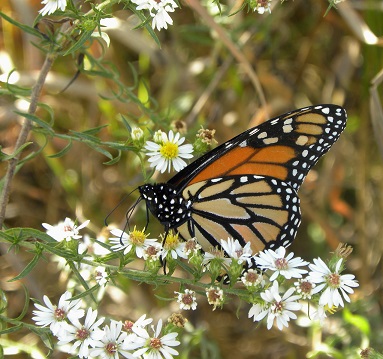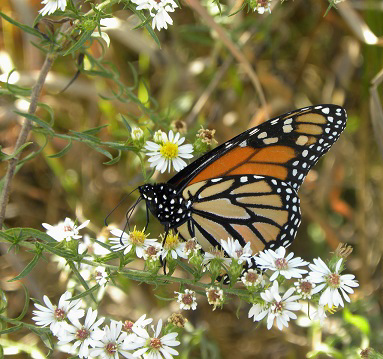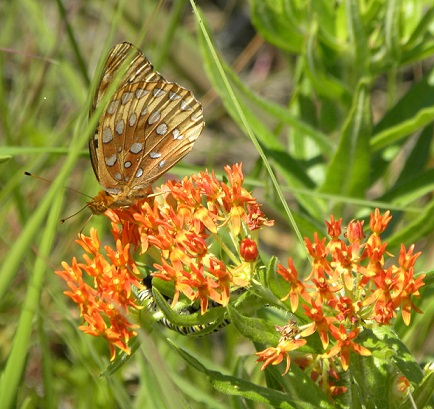A Monarch Waystation at the Library

Monarch Butterfly (photo by Kim Sain)
Statistics show the 2013-2014 overwintering numbers of the monarch butterfly declined again and were the lowest numbers recorded since 1993. Why is this happening? Scientists point to the reduction of native milkweeds as a primary reason for the population decline. Milkweeds are the only host plants used by monarchs to lay their eggs and for the caterpillars to feed on, so they need these plants to survive.
Agricultural methods eliminating native milkweeds, as well as other environmental changes affecting monarch's habitat including land development, extreme climatic events such as prolonged periods of drought, and illegal logging in patches of forests in Mexico where monarchs spend the winter all contribute to a reduced monarch population.
The monarch's migratory route includes Kansas, but did you know there are three generations of monarchs that will reside here during the annual migration?
To help sustain monarch migration, researchers encourage everyone to plant more nectar sources and native milkweeds, which will also benefit other pollinators important for our ecosystem. Plants that bloom throughout the growing season provide energy before and during migration, and give monarchs the required nutrition for reproduction.
Library staff member John Cooper, who maintains the Library's landscape, improved the soil quality in the designated garden plot and prepped it for planting. Members of the Lawn and Garden Neighborhood researched annual and perennial nectar plants that should grow well in our area, and plotted our garden on paper before planting. We met Monarch Watch's 2-10 plants per square yard recommendation, with milkweeds and nectar sources planted in close proximity which should bloom May thru early fall. We focused heavily on perennial nectar plants and will plant different annuals next spring. This year's annuals include Lantana and two varieties of Zinnia. Perennials in addition to the common milkweeds include Butterfly Bush, Blue Mist Spirea,, Sedum, Joe-Pye Weed, Yarrow, Russian Sage, Goldenrod, Purple Coneflower, and Bee Balm.
Stop by our Monarch Waystation (near the flag pole) and watch for monarchs and other butterfly species, pollinators such as bumblebees, and even hummingbirds, and get inspired to plant your own Monarch Waystation!
Additional Resources
Monarch WatchJourney NorthHow Do Monarchs Find Milkweed? slideshow
Monarch Butterfly Recovery PlanWichita Eagle articleThe Last Monarch ButterflyButterflies of Oklahoma, Kansas and North TexasTSCPL Monarch Waystation Photo Album










